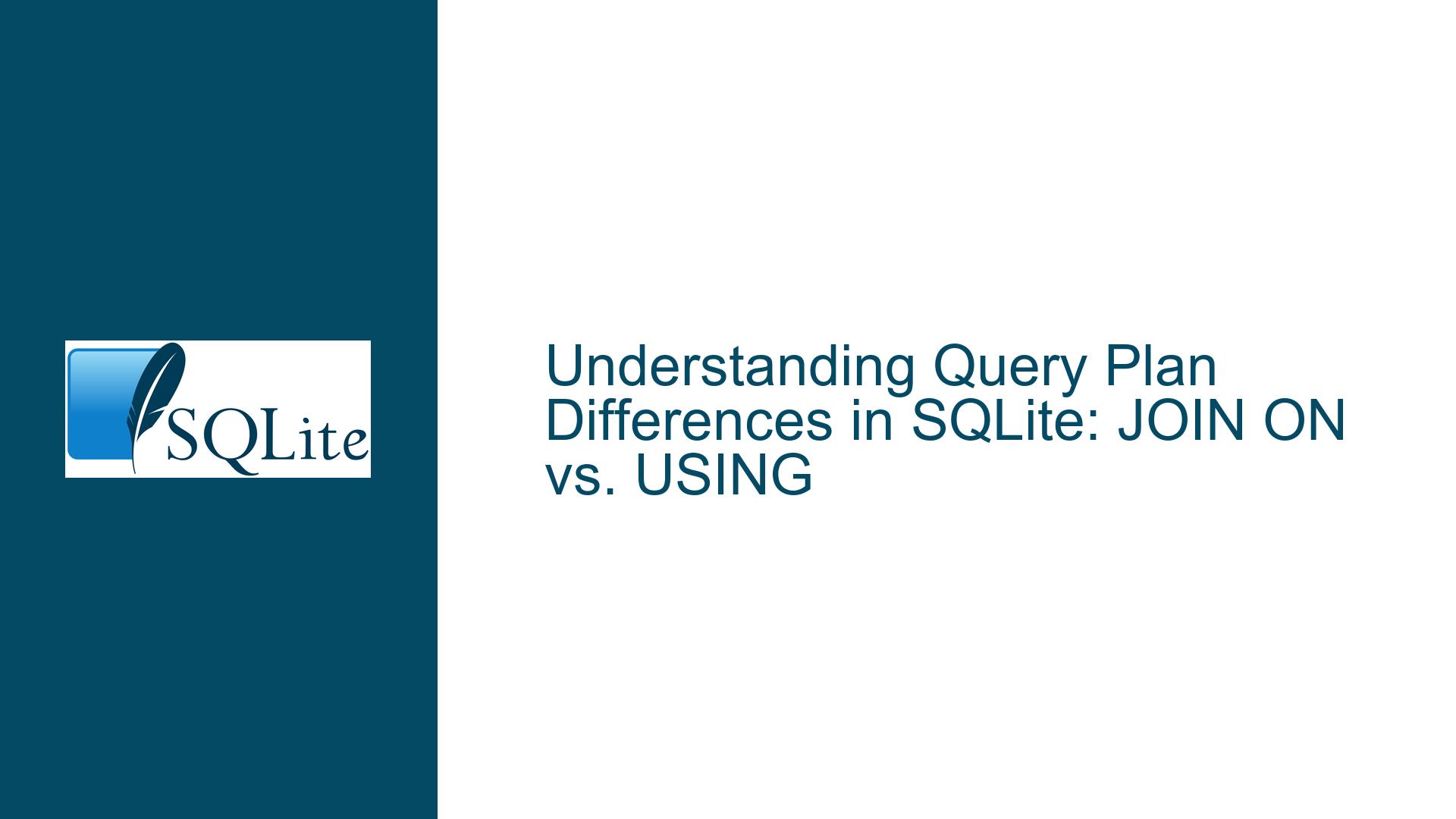Query Plan Differences in SQLite: JOIN ON vs. USING
Issue Overview: Different Query Plans for JOIN ON and JOIN USING
When working with SQLite, the choice between using JOIN ON and JOIN USING can lead to significantly different query execution plans, even when the logical outcome of the queries is identical. This discrepancy arises due to how SQLite’s query optimizer interprets and processes these two forms of joins. The issue becomes particularly pronounced when joining views or complex subqueries, where the optimizer’s ability to push down predicates and utilize indexes effectively can vary between the two syntaxes.
In the provided scenario, two queries were executed: one using JOIN ON and the other using JOIN USING. Both queries join the most_recent_work_event view with the premier_rate_shifts_completed view on the user_id column and filter the results for a specific user_id. Despite producing the same results, the query plans differ substantially. The JOIN USING query results in a more performant execution plan, where the predicate (user_id = 1071620) is pushed down into both views, allowing the optimizer to leverage indexes more effectively. In contrast, the JOIN ON query fails to push the predicate into the views, leading to a less efficient plan.
This behavior is counterintuitive because, according to SQLite’s documentation, USING clauses are internally converted into equivalent ON clauses. However, the optimizer’s handling of these clauses during query planning can lead to different execution strategies, particularly when dealing with views or subqueries. Understanding why this happens requires a deep dive into SQLite’s query optimization process, the role of predicate pushdown, and how the optimizer interprets JOIN ON versus JOIN USING.
Possible Causes: Why JOIN ON and JOIN USING Yield Different Query Plans
The discrepancy in query plans between JOIN ON and JOIN USING can be attributed to several factors related to SQLite’s query optimizer and its handling of views and predicates. Below are the key reasons why these differences occur:
Predicate Pushdown Behavior: Predicate pushdown is a critical optimization technique where filters (predicates) are pushed as close as possible to the data source, ideally into the base tables or views. This allows the database to reduce the amount of data processed early in the query execution, leading to better performance. In the case of
JOIN USING, SQLite’s optimizer is more aggressive in pushing theuser_idpredicate into both views (most_recent_work_eventandpremier_rate_shifts_completed). This results in a more efficient query plan, as the views are filtered before the join operation. However, withJOIN ON, the optimizer does not push the predicate into the views, leading to a less efficient plan where the filtering occurs after the join.View Materialization: Views in SQLite are essentially saved queries that are executed when referenced in a query. The optimizer’s ability to optimize queries involving views depends on how it materializes these views. When using
JOIN USING, the optimizer appears to recognize that theuser_idpredicate can be applied directly to the underlying tables within the views, avoiding unnecessary materialization of the entire view. In contrast,JOIN ONmay cause the optimizer to materialize the full view before applying the predicate, resulting in a less efficient plan.Index Utilization: The effectiveness of index usage can vary between
JOIN ONandJOIN USING. In the provided example, theJOIN USINGquery plan shows the use of an "AUTOMATIC PARTIAL COVERING INDEX," which suggests that the optimizer is able to leverage an index onuser_idmore effectively. This is likely due to the predicate being pushed down into the views, allowing the optimizer to use the index for filtering. WithJOIN ON, the optimizer may not recognize the opportunity to use the index in the same way, leading to a less efficient plan.Optimizer Heuristics: SQLite’s query optimizer uses heuristics to determine the best execution plan. These heuristics can sometimes lead to suboptimal decisions, especially in complex queries involving views or subqueries. The optimizer’s handling of
JOIN ONandJOIN USINGmay be influenced by these heuristics, resulting in different plans even when the logical outcome is the same.Implicit vs. Explicit Join Conditions: The
JOIN USINGsyntax implicitly equates the specified columns (user_idin this case) across the joined tables or views. This implicit equality may provide the optimizer with more information about the relationship between the tables, allowing it to make better optimization decisions. In contrast,JOIN ONrequires an explicit condition, which may not provide the same level of clarity to the optimizer.
Troubleshooting Steps, Solutions & Fixes: Addressing Query Plan Discrepancies
To address the issue of differing query plans between JOIN ON and JOIN USING, several steps can be taken to ensure optimal query performance. These steps involve understanding the underlying causes, modifying the query structure, and leveraging SQLite’s features to guide the optimizer.
Analyze Query Plans: The first step in troubleshooting query performance issues is to analyze the query plans using the
EXPLAIN QUERY PLANstatement. This provides insight into how SQLite is executing the query and where potential inefficiencies lie. In the provided example, the query plans forJOIN ONandJOIN USINGwere compared, revealing differences in predicate pushdown and index usage. Regularly analyzing query plans can help identify similar issues in other queries.Force Predicate Pushdown: If the optimizer is not pushing predicates into views or subqueries, you can manually force predicate pushdown by restructuring the query. One effective approach is to use subqueries with explicit
WHEREclauses to filter the data before joining. For example:SELECT mrw.*, COALESCE(prsc.shifts_completed_last_month, 0) AS shifts_completed_last_month, COALESCE(prsc.shifts_completed_this_month, 0) AS shifts_completed_this_month FROM ( SELECT * FROM most_recent_work_event WHERE user_id = 1071620 ) AS mrw LEFT JOIN ( SELECT * FROM premier_rate_shifts_completed WHERE user_id = 1071620 ) AS prsc ON mrw.user_id = prsc.user_id;This approach ensures that the
user_idpredicate is applied to both views before the join, mimicking the behavior ofJOIN USING.Use Indexed Columns: Ensure that the columns used in join conditions and predicates are indexed. In the provided example, the
user_idcolumn is indexed in thework_historytable, which is the underlying table for both views. However, the optimizer’s ability to use these indexes depends on how the query is structured. By explicitly filtering on indexed columns before joining, you can guide the optimizer to use the indexes more effectively.Rewrite Views: If views are causing performance issues due to inefficient materialization, consider rewriting them to be more optimizer-friendly. For example, you can create indexed views or materialized views that store precomputed results. Alternatively, you can replace views with common table expressions (CTEs) or subqueries that allow for more granular control over predicate pushdown and index usage.
Leverage SQLite’s ANALYZE Command: SQLite’s
ANALYZEcommand collects statistics about the distribution of data in tables and indexes, which the optimizer uses to make better decisions. RunningANALYZEon the database can improve the optimizer’s ability to choose efficient query plans. For example:ANALYZE;This command updates the
sqlite_stat1table with statistics that help the optimizer estimate the cost of different query plans more accurately.Experiment with Query Syntax: In some cases, minor changes to the query syntax can lead to significant improvements in query performance. For example, using
INNER JOINinstead ofLEFT JOINwhen appropriate can reduce the amount of data processed. Similarly, usingEXISTSorINclauses instead of joins can sometimes lead to more efficient plans. Experimenting with different syntaxes and analyzing their query plans can help identify the most performant approach.Consider Query Hints: While SQLite does not support explicit query hints like some other databases, you can influence the optimizer’s decisions by structuring the query in specific ways. For example, using
ORDER BYorLIMITclauses can sometimes guide the optimizer to choose a more efficient plan. Additionally, breaking down complex queries into smaller, more manageable parts can help the optimizer make better decisions.Monitor and Optimize Database Schema: The structure of the database schema can have a significant impact on query performance. Ensure that tables are properly normalized, and consider denormalizing only when necessary for performance reasons. Regularly review and optimize indexes, removing unused or redundant indexes that can slow down write operations and complicate the optimizer’s decision-making process.
By following these steps, you can address the issue of differing query plans between JOIN ON and JOIN USING and ensure that your SQLite queries are optimized for performance. Understanding the nuances of SQLite’s query optimizer and how it handles different join syntaxes is key to achieving efficient and reliable query execution.






